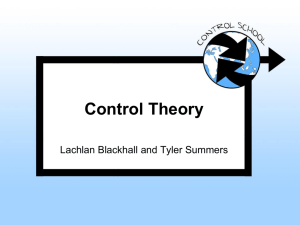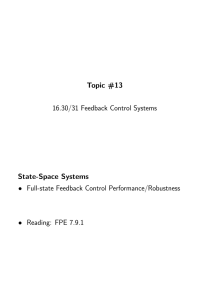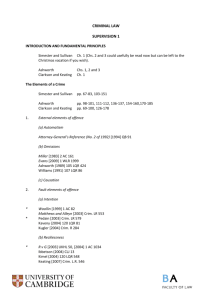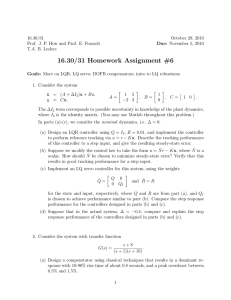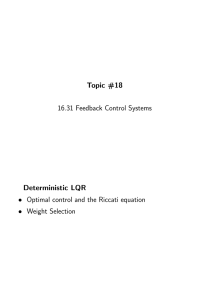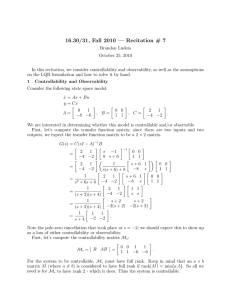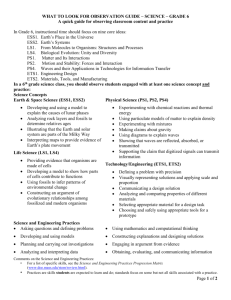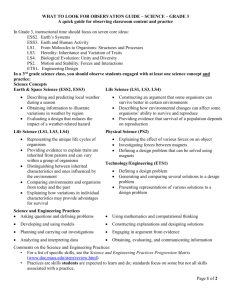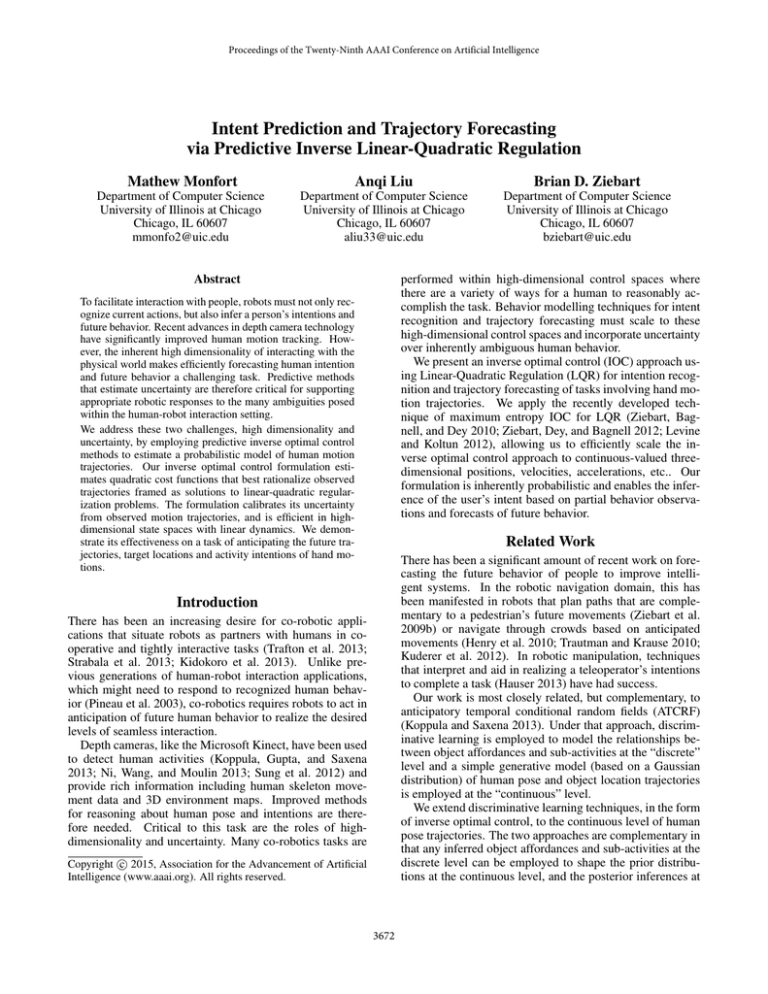
Proceedings of the Twenty-Ninth AAAI Conference on Artificial Intelligence
Intent Prediction and Trajectory Forecasting
via Predictive Inverse Linear-Quadratic Regulation
Mathew Monfort
Anqi Liu
Brian D. Ziebart
Department of Computer Science
University of Illinois at Chicago
Chicago, IL 60607
mmonfo2@uic.edu
Department of Computer Science
University of Illinois at Chicago
Chicago, IL 60607
aliu33@uic.edu
Department of Computer Science
University of Illinois at Chicago
Chicago, IL 60607
bziebart@uic.edu
Abstract
performed within high-dimensional control spaces where
there are a variety of ways for a human to reasonably accomplish the task. Behavior modelling techniques for intent
recognition and trajectory forecasting must scale to these
high-dimensional control spaces and incorporate uncertainty
over inherently ambiguous human behavior.
We present an inverse optimal control (IOC) approach using Linear-Quadratic Regulation (LQR) for intention recognition and trajectory forecasting of tasks involving hand motion trajectories. We apply the recently developed technique of maximum entropy IOC for LQR (Ziebart, Bagnell, and Dey 2010; Ziebart, Dey, and Bagnell 2012; Levine
and Koltun 2012), allowing us to efficiently scale the inverse optimal control approach to continuous-valued threedimensional positions, velocities, accelerations, etc.. Our
formulation is inherently probabilistic and enables the inference of the user’s intent based on partial behavior observations and forecasts of future behavior.
To facilitate interaction with people, robots must not only recognize current actions, but also infer a person’s intentions and
future behavior. Recent advances in depth camera technology
have significantly improved human motion tracking. However, the inherent high dimensionality of interacting with the
physical world makes efficiently forecasting human intention
and future behavior a challenging task. Predictive methods
that estimate uncertainty are therefore critical for supporting
appropriate robotic responses to the many ambiguities posed
within the human-robot interaction setting.
We address these two challenges, high dimensionality and
uncertainty, by employing predictive inverse optimal control
methods to estimate a probabilistic model of human motion
trajectories. Our inverse optimal control formulation estimates quadratic cost functions that best rationalize observed
trajectories framed as solutions to linear-quadratic regularization problems. The formulation calibrates its uncertainty
from observed motion trajectories, and is efficient in highdimensional state spaces with linear dynamics. We demonstrate its effectiveness on a task of anticipating the future trajectories, target locations and activity intentions of hand motions.
Related Work
There has been a significant amount of recent work on forecasting the future behavior of people to improve intelligent systems. In the robotic navigation domain, this has
been manifested in robots that plan paths that are complementary to a pedestrian’s future movements (Ziebart et al.
2009b) or navigate through crowds based on anticipated
movements (Henry et al. 2010; Trautman and Krause 2010;
Kuderer et al. 2012). In robotic manipulation, techniques
that interpret and aid in realizing a teleoperator’s intentions
to complete a task (Hauser 2013) have had success.
Our work is most closely related, but complementary, to
anticipatory temporal conditional random fields (ATCRF)
(Koppula and Saxena 2013). Under that approach, discriminative learning is employed to model the relationships between object affordances and sub-activities at the “discrete”
level and a simple generative model (based on a Gaussian
distribution) of human pose and object location trajectories
is employed at the “continuous” level.
We extend discriminative learning techniques, in the form
of inverse optimal control, to the continuous level of human
pose trajectories. The two approaches are complementary in
that any inferred object affordances and sub-activities at the
discrete level can be employed to shape the prior distributions at the continuous level, and the posterior inferences at
Introduction
There has been an increasing desire for co-robotic applications that situate robots as partners with humans in cooperative and tightly interactive tasks (Trafton et al. 2013;
Strabala et al. 2013; Kidokoro et al. 2013). Unlike previous generations of human-robot interaction applications,
which might need to respond to recognized human behavior (Pineau et al. 2003), co-robotics requires robots to act in
anticipation of future human behavior to realize the desired
levels of seamless interaction.
Depth cameras, like the Microsoft Kinect, have been used
to detect human activities (Koppula, Gupta, and Saxena
2013; Ni, Wang, and Moulin 2013; Sung et al. 2012) and
provide rich information including human skeleton movement data and 3D environment maps. Improved methods
for reasoning about human pose and intentions are therefore needed. Critical to this task are the roles of highdimensionality and uncertainty. Many co-robotics tasks are
c 2015, Association for the Advancement of Artificial
Copyright Intelligence (www.aaai.org). All rights reserved.
3672
the continuous-level can feed into inferences at the discrete
level. Our approach differs in its applicability to continuousvalued control settings and in employing a maximum entropy formulation rather than a non-probabilistic maximummargin estimation approach.
Early work was conducted in inverse optimal control (Ng
and Russell 2000) to learn appropriate control policies for
planning and navigation (Ratliff, Silver, and Bagnell 2009).
These, and related maximum margin approaches (Ratliff,
Bagnell, and Zinkevich 2006), are non-probabilistic. Recent
probabilistic approaches (Ziebart et al. 2009b; Wang et al.
2012) construct probability distributions over behaviors and
can be used to infer unknown intentions or future behavior
given a partially-completed observation. Maximum entropy
inverse optimal control (Ziebart et al. 2008) has been shown
to elicit strong results by maximizing the uncertainty in the
probabilistic inference task (Ziebart et al. 2009a). Extensions to the linear-quadratic setting have been applied to predicting the intended targets of computer cursor movements
(Ziebart, Dey, and Bagnell 2012) detailing the benefit of using the demonstrated continuous trajectory for target prediction. There has also been recent work in the area of action
inference and activity forecasting from video (Kitani et al.
2012), however this work discretizes the state space in such
a way that would be impractical for inferring at useful granularities in higher dimensional (three or more) spaces.
We extend the maximum entropy inverse optimal control
linear quadratic regulator model (Ziebart, Dey, and Bagnell
2012) to the task of predicting target intentions and inferring continuous hand motion trajectories using depth camera
data. This is directly applicable to the areas of activity prediction (Koppula and Saxena 2013) and behavior forecasting
(Ziebart et al. 2009b).
where (x˙t , y˙t , z˙t ) represent the velocities, and (x¨t , y¨t , z¨t )
represent the accelerations. A constant of 1 is added to the
state representation in order to incorporate linear features
into the quadratic cost function formulation described later.
Importantly, when actions, at represent the velocities
specifying changes in positions between current state and
next state, the state dynamics follow a linear relationship:
st+1 = Ast + Bat + t , where the noise, t , is drawn
from a zero-mean Gaussian distribution. We represent the
distribution over next state using the transition probability
distribution P (st+1 |st , at ). Though many tasks may have
non-linear dynamics or be motivated by non-quadratic cost
functions, the LQR simplification is important when considering the fast execution time needed for true human-robot interaction. If needed, additional features can be added to the
state in order to further incorporate higher-order attributes of
the trajectory, like jerks. In addition to efficiency, this state
definition provides a strong set of informative features for
defining (or estimating) a cost function. While the position
is clearly correlated with the intended target, the motion dynamics offer a more distinct descriptive behavior in terms of
completing differing tasks (Filipovych and Ribeiro 2007).
In order to account for the high level of variance with respect to the xyz goal positions of the demonstrated trajectories obtained from the depth camera data, we extend the
LQR method (Ziebart, Dey, and Bagnell 2012) and add an
additional parameter matrix to the existing cost matrix M.
We call this matrix Mf to signify that it only applies to the
final state of the trajectory. This set of parameters adds an
additional penalty to the final state for deviating far from the
desired goal state features. So the cost functions are:
T
a
a
cost(st , at ) = t M t , t < T,
(1)
st
st
Approach
cost(sT ) = (sT − sG )T Mf (sT − sG ).
We propose a predictive model of motion trajectories trained
from a dataset of observed depth camera motions using a
linear quadratic regulation framework. Under this framework, a linear state dynamics model and a quadratic cost
function are assumed. The optimal control problem for this
formulation is to find the best control action for each possible state that minimizes the expectation of the cost function
over time. In contrast, we estimate the cost function that
best rationalizes demonstrated trajectories in this work. Our
approach provides a probabilistic model that allows us to
reason about the intentions of partially completed trajectories.
(2)
To increase the generalization of the model to all possible xyz conditions, we sparsify the two parameter matrices
so that we only train parameters relating to the dynamics
features, velocity and acceleration, for M, and only train
parameters relating to xyz positions for Mf . Therefore, all
quadratic feature combinations that include an xyz position
feature in M or a velocity, or acceleration, feature in Mf
will have a parameter value of 0. This is helpful in the case
where the xyz coordinates differ greatly across the demonstrated trajectories and allows for M to learn the behavior of
the trajectories rather than the true positions. Likewise, Mf
can then serve solely as a position penalty for the final inferred position deviating from the desired goal location and
avoid penalizing the velocity and acceleration of the final
state. This helps to generalize the model across different
orientations and behaviors.
State Representation and Quadratic Cost Matrices
One of the main benefits of the proposed technique is the
ability to use a simple and generalizable state model. For
the task at hand, we consider the xyz positions of the center
of the hand as well as the velocities and accelerations in each
respective axis. Adding one constant term to capture the linear cost, we have 10 dimensions in the state representation.
The state at time step t is then defined as:
Inverse Linear-Quadratic Regulation for
Prediction
We employ maximum causal entropy inverse optimal control (Ziebart, Bagnell, and Dey 2013) to the linear quadratic
regulation setting to obtain estimates for our cost parameter
st = [xt , yt , zt , x˙t , y˙t , z˙t , x¨t , y¨t , z¨t , 1]T ,
3673
matrices, M and Mf . These estimates result from a constrained optimization problem maximizing causal entropy,
" T
#
X
H(a||s) , Eπ̂ −
log π̂(a||s) ,
where Qcvt and Vcvt are scalars. The matrices of these values are recursively defined as:
t=1
Cst ,at = A Dt+1 B+Ms,a ; Cst ,st = A Dt+1 A+Ms,s ;
T
Dt = Cst+1 ,st+1 −
T
−1
Ca
Fat+1 .
t+1 ,st+1
t+1 ,at+1
We derive these updates in a supplemental appendix.
Bayesian Intention and Target Prediction
Given a unique learned trajectory model for each intention,
I, the observed partial state sequence, s1:t , the prior probability distribution over the duration of the total sequence, T ,
and the goal, G, we employ Bayes’ rule to form the posterior
probability distribution of the possible targets:
P (G, I, T |s1:t ) ∝
t
Y
π(at |st , G, I, T )P (G, I, T ).
(7)
τ =1
The Bayesian formulation enables us to use a flexible prior
distribution over the goals and intentions that reflects our
initial belief given relevant environment information, such
as pre-defined task type, object affordance and distance with
objects. This allows for any method that estimates a strong
prior distribution to be combined with the LQR model in
order to improve the predictive accuracy.
where sG represents a goal state that is used to specify a
penalty for a trajectory’s final distance from the desired goal
and the softmax function is a smoothed interpolation
of the
Z
f (x)
maximum function, softmax f (x) = log e
dx.
Complexity Analysis
When the dynamics are linear, the recursive relation of
Equations 5 and 6 have closed-form solutions that are
quadratic functions and the action distribution is a conditional Gaussian distribution. This enables more efficient
computation for large time horizons, T , with a large continuous state and action space than could be computed in the
discrete case.
For trajectory inference, the proposed technique only requires O(T ) matrix updates as detailed in the appendix. A
strong advantage of this model is the fact that the matrix
updates only need to be computed once when performing
inference over sequences sharing the same time horizon and
goal position. In order to further improve the efficiency of
our computation we employ the Armadillo C++ linear algebra library for fast linear computation (Sanderson 2010).
x
Using this formulation, the recurrence of Equation 5 and
6 can be viewed as a probabilistic relaxation of the Bellman
criteria for optimal control; it selects actions with smaller expected future costs in Equation 5 and recursively computes
those future costs using the expectation over the decision
process’s dynamics in Equation 6. The Q and V functions
are softened versions of the optimal control state-action and
state value functions, respectively. Inference is performed
by forming a set of time-specific update rules that are used
to compute state and action values which are conditioned on
the goal state, trajectory length, and the cost parameter values. We refer to the appendix for details of this method.
The probability of a trajectory of length T is then easily
t
Y
Pt−1
computed as:
π(at |st , G, I, T ) = e τ =1 Q(at ,st )−V (st ) ,
Experimental Setup
τ =1
where G is the goal location of the trajectory and I is
the characteristic intention/behavior of the movement (ex.
reaching, placing, eating, etc.).
The recursive Q and V calculations simplify to a set of
matrix updates in the LQR setting:
T
T
Fst = A Gt+1 ;
T
−1
Ca
Ca
Cat+1 ,st+1 ;
t+1 ,st+1
t+1 ,at+1
Gt = Fst+1 − Ca
π̂(at |st ) = eQ(st ,at )−V (st ) ,
(4)
Q(st , at ) = Eτ (st+1 |st ,at ) [V (st+1 |st , at )] + cost(st , at ),
(5)
(
t<T
softmax Q(st , at ),
at
V (st ) =
(6)
T
(st − sG ) Mf (st − sG ), t = T,
#T "
at
Cat ,at
Q(st , at ) =
st
Cst ,at
T
T
Fat = B Gt+1 ;
This set of constraints ensures that the trajectory’s dynamic
properties are maintained by the control policy estimate, π̂.
Solving this problem, we obtain a state-conditioned probabilistic policy π̂ over actions that are recursively defined
using the following equations:
"
T
T
Cat ,at = B Dt+1 B+Ma,a ; Cat ,st = B Dt+1 A+Ma,s ;
so that the predictive policy distribution, π̂(a||s) =
π(a1 |s1 )π(a2 |s2 ) · · · π(aT |sT ), matches the quadratic state
properties of the demonstrated behavior, π̃, in feature expectation where:
"T −1 #
"T −1 #
T
T
X a
X a
at
at
t
t
Eπ̂
= Eπ̃
and (3)
st st
st st
t=1
t=1
Eπ̂ (sT − sG )(sT − sG )T = Eπ̃ (sT − sG )(sT − sG )T .
x
GT = −2Mf sG ;
DT = Mf ;
for t in T − 1...1
We employ the Cornell Activity Dataset (CAD-120) (Koppula and Saxena 2013) in order to analyze and evaluate our
predictive inverse linear-quadratic regulation model.
Cornell Activity Dataset
The dataset consists of 120 depth camera videos of long
daily activities. There are 10 high-level activities: making cereal, taking medicine, stacking objects, unstacking objects, microwaving food, picking objects, cleaning objects,
#
#" # " #T "
at
Fat
Cat ,st at
+Qcvt ,
+
Fst
Cst ,st
st
st
T
V (st ) = st Dt st +st Gt +Vcvt ,
3674
observed distribution to compute the probable endpoints for
the test trajectories. Since the placing sub-activity has no
target object, points are randomly chosen on the placeable
surfaces in the scene.
taking food, arranging objects and having a meal. These
high-level activities are then divided into 10 sub-activities:
reaching, moving, pouring, eating, drinking, opening, placing, closing, cleaning and null. Here, we regard different
types of sub-activity as different intentions.
Consider the task of pouring cereal into a bowl. We
decompose this high-level activity into the following subactivities: reaching (cereal box), moving (cereal box above
bowl), pouring (from cereal box to a bowl), moving (cereal
box to table surface), placing (cereal box to table surface),
null (moving hand back).
Segmentation and Duration Sampling When deployed
in real world applications the separation of intentions may
not be clear. For this reason it is necessary to include a
method to detect segmentation. The incorporation of T
in Equation 7 allows for the direct inclusion of segmentation inference as an inherent feature of the proposed LQR
method. This is due to the fact that goals, intentions, and
duration are grouped together in each prediction.
The inclusion of duration is important as a poor prediction
of the end of the current sub-activity will lead to an inaccurate starting step for the next sub-activity. For this reason it
is necessary to achieve an accurate estimate of the length of
each sub-activity.
Our LQR model requires that we specify a length for
the total trajectory. Since we are only observing a part
of this trajectory prior to forming a prediction, it is necessary to infer this duration. Here we use the observed average distance covered by each action for each sub-activity
with the remaining distance to be covered from the current
point and the sampled target point in order to infer a probable duration. This is done using the following equation:
T = t + dist(st , sg )/avgdista . This value, T , represents the
inferred segmentation for sub-activity a and target sg .
Modifications The goal of the moving sub-activity is dependent on the sub-activity it precedes. For instance, if the
next sub-activity is placing, then the goal of moving will be
some location above the target surface of the placing subactivity, but if the next sub-activity is eating, then the goal
will be the area around the mouth. Therefore, we regard the
moving sub-activity as the beginning portion of the latter
sub-activity and combine them as one. We ignore the null
sub-activity due to its lack of intention or goal.
In a similar fashion, we also separate the opening subactivity into two different sub-activities, opening a microwave and opening a jar. The actions in these two tasks
have very different movements and goals, and thus are considered as separate sub-activities. This results in nine subactivity classifications, each of which we regard as a trajectory type with a target and intent.
Test set The data is randomly divided into a training set
and a test set. The test set consists of 10% of the demonstrated sequences with at least one sequence belonging to
each sub-activity. The model is then trained on the training
set and evaluated using the test set.
Prior Distributions
In order to improve the predictive accuracy, it is often helpful to include a prior distribution on the sampled target
points. This allows for the inclusion of additional knowledge about the problem domain to be added to the inference
model. Here, the priors enable us to use the context information of the human robot interaction which is not included in
trajectory data in our model. We use two prior distributions
for this purpose which we join together into a single distribution due to the tuple nature of the sampled sub-activity
and target points.
We evaluate the inverse LQR technique against 4 different
probabilistic prediction methods, nearest target, nearest target from extended trajectory, a sub-activity sequence Naive
Bayes distribution, and a combination of nearest target and
the sub-activity sequence distribution which is also used as
a prior distribution for our proposed LQR method.
Model Fitting
Estimating the Quadratic Parameters Our LQR model
uses two separate parameter matrices, M and Mf . We employ accelerated stochastic gradient descent with an adaptive
(adagrad) learning rate and L1 regularization (Duchi, Hazan,
and Singer 2011; Sutskever et al. 2013) on both parameter matrices simultaneously. This regularized approach prevents overfitting of the parameter matrices for sub-activities
with a low number of demonstrated trajectories.
Target and Intention Sampling
Intention Sampling In the prediction task we separate the
sub-activities into two categories, those that require an object in the hand and those that do not. This eliminates tasks
from consideration that lack the required presence or absence of an object. For example, when the task is placing
an object and there is no object in the hand.
Target Distance Prior For the nearest target prior we use
the Euclidean distance from the final state of the observed
trajectory, st , and the sampled target, sg , and a strength coefficient, α, in order to form a probability distribution over
the possible target points using the following equation:
p(sg |st ) ∝ e−αdist(st ,sg ) .
(8)
Markov Intention Prior Here we use a second order
Markov model to form the probability distribution of a subactivity given the previous two observed sub-activities in the
sequence:
N (ai , ai−1 , ai−2 )
p(ai |ai−1 , ai−2 ) =
,
(9)
N (ai−1 , ai−2 )
Target Sampling Target points are chosen for each subactivity according to a Gaussian distribution of the observed
endpoints of the active hand and the target object in the training data. The target object for the eating and drinking sub–
activities are the head joint and the target for the placing
sub-activity is the true endpoint of the active hand trajectory.
The skeleton and object tracking data are then used with this
3675
Average log-loss for current target prediction
with N (ai , ai−1 , ai−2 ) being the number of occurrences of
activity ai being preceded by the two activities, ai−1 and
ai−2 in the training dataset.
Distance
Distance and activity
LQR flat prior
LQR distance prior
LQR activity prior
LQR full prior
Average log-loss
5
Combining for a Full Prior The above two prior distributions are then combined together in order to form a distribution over both the sub-activity and the location of the
sampled target points with a simple method: p(sg , ai ) ∝
p(ai |ai−1 , ai−2 )p(sg |st ).
4
3
2
1
0
0.1
Prediction
Current and Next Target We calculate probabilistic predictions for each sampled target using our LQR method (7).
Here the trajectory of the most active hand is observed and
used to develop a likelihood model for each target.
When predicting the probability of the next target
(the target following the not-yet-reached current target),
we use the calculated probability of the current target
and the target points in order to develop a distribution for the next target point. Since there is no trajectory to observe for the next target, this reduces to simply using the prior distribution of the next targets and
the probability distribution of the current target given
the current partial trajectory: P (Gi+1 , Ii+1 , Ti+1 |s1:t ) ∝
P (Gi , Ii , Ti |s1:t )P (Gi+1 , Ii+1 , Ti+1 |Gi , Ii , Ti ).
0.2
0.3
0.4
0.5
0.6
0.7
Fraction of trajectory observed
0.8
0.9
1
Figure 1: Average predictive loss of current target with partially observed trajectories. We compare the results of the
distance and the distance-activity full prior with LQR.
predictions for the 63 trajectories of the test set in 1.052 seconds total with the parallel training of the parameters for all
nine of the sub-activity types taking less than an hour. These
execution times were collected on an Intel i7-3720QM CPU
at 2.60GHz with 16 GB of RAM.
The use of linear dynamics in the models allows for this
efficient computation which is extremely important when inferring over quickly executed sequences that require fast reactions using the predicted results. In addition, relative positions were not used in the state formulation since the time
to compute a different relative sequence of states/actions for
each possible target combination could result in non-realtime computation which is of key importance for humanrobot-interaction. The speeds described above for the entire dataset translates to a target inference rate of over
1000Hz for real-time applications. This is a frequency that is
many orders of magnitude greater than the discrete ATCRF
method of inference (Koppula and Saxena 2013).
Notes on Segmentation Prediction In addition to the direct inference of segmentation, many sub-activities contain
clear discernible goal behaviors. For instance, the placing
sub-activity will end with the active hand releasing an object. If the object is tracked, which is necessary for target
sampling, we can easily determine when this takes place
and the hand moves away from the placed object. This is
also the case for reaching, which ends when the hand is in
contact with an object.
Utilizing these characteristics and accurate estimates of
the duration yields impressive results for segmentation inference. We are able to achieve perfect segmentation detection
once the hands move close enough to the inferred target to
get an accurate estimate of the remaining duration, notably
once the goal is reached or passed. This is also evident in
the improved log-loss, which represents the probability of
the true duration, goal, and intention.
Predictive Results
We compare the predictive accuracy of our method against
the aforementioned techniques using the averaged mean logloss (Begleiter, El-yaniv, and Yona 2004; Nguyen and Guo
2007). This allows us to compare the likelihood of the
demonstrated trajectory to the distance and activity measures previously discussed. As we show in Figure 1, the presented LQR method outperforms the other predictive techniques. This is mainly due to the incorporation of our sophisticated LQR likelihood model for the demonstrated sequence trajectories with the prior target distribution.
The activity prior is independent of the percentage of the
sequence that is observed with an averaged mean log-loss
for the activity model of 4.54. While this is not very good
on its own, it does add a significant improvement to the LQR
model when incorporated as a prior. Likewise, the nearesttarget distance model gives an additional boost to the results
of the LQR model when added as a prior with the combination of the two priors gave the best results. The improvement
seen in Figure 1 is then extended to the predictive results for
the target of the next sub-activity in Figure 2. Each of the
models uses the same technique to compute the next target
Evaluation
Comparison Metrics
We evaluate the inverse LQR technique against the probability distributions obtained from calculating the three prior
methods. These are the nearest target distribution, the
Markov model on the sub-activity sequence, and the full
prior distribution that is a combination of the two.
We compare these distributions against the LQR model
with a flat distribution prior, and with each of the above respective distributions as priors.
Execution Time
In many tasks using predictive inference, it is important to
minimize the execution time of the inference task. In this
case, the proposed LQR method models, infers and makes
3676
4
Average log-loss for next target prediction
for us to use the true starting point for each sub-activity.
In addition, the LQR technique, given only 40% of the
sequence obtains comparable results to the ATCRF model
given the entire sequence. This is a significant result since
the ability to predict the target and intention early on in a
sequence is highly beneficial to many applications including
human-robot interaction.
We note that the ATCRF results are on the unmodified CAD-120 dataset. As mentioned previously, we have
merged the moving sub-activity with its succeeding subactivity and separated the opening task into two different
sub-activities. While this produces a more straight forward
sampling task, it also makes the first half of the demonstrated sequences more ambiguous and segmentation more
difficult. This is due to the similar dynamics of the moving
sub-activity as compared to the other sub-activities. However, our results show that the proposed LQR method is robust enough to generate strong performance after only observing the first 20% of the sequence.
Average log-loss
3.5
3
2.5
2
0.1
Distance
Distance and activity
LQR flat prior
LQR distance prior
LQR activity prior
LQR full prior
0.2
0.3
0.4
0.5
0.6
0.7
0.8
0.9
1
Percentage of current trajectory observed
Figure 2: Average predictive loss of next target with partially
observed trajectories. We compare the results of the distance
and the distance-activity full prior with LQR.
Results Comparison with Ground Truth Segmentation
Method
Accuracy Macro
Macro
Precision Recall
LQR 20% sequence
80.9 ± 2.4 65.0 ± 3.1 77.3 ± 2.4
LQR 40% sequence
82.5 ± 3.2 73.4 ± 2.2 91.4 ± 0.6
LQR 60% sequence
84.1 ± 0,9 79.1 ± 2.5 94.2 ± 0.6
LQR 80% sequence
90.4 ± 0.4 87.5 ± 1.8 96.2 ± 0.3
LQR 100% sequence
100 ± 0.0 100 ± 0.0 100 ± 0.0
ATCRF 100% sequence 86.0 ± 0.9 84.2 ± 1.3 76.9 ± 2.6
Discussion
In this paper we have shown that incorporating the dynamics of a trajectory sequence into a predictive model elicits a
significant improvement in the inference of target locations
and activities for human task completion. We did this using
linear quadratic regulation trained with maximum entropy
inverse optimal control and have shown that using linear dynamics in forming a model for task and target prediction improves intention recognition while providing efficient computation of the inferred probability distributions.
The combination of efficient inference with strong predictive results yields a very promising technique for any
field that requires the predictive modelling of decision processes in real time. This is especially important in the area
of human-robot collaboration where a robot may need to react to the inferred intentions of a human collaborator before
they complete a task, which is an application that the authors
plan to undertake in the near future.
While the results reported improve upon the conditional
random field (ATCRF) technique (Koppula and Saxena
2013), we feel the best results can be obtained by incorporating the discrete distribution learned using the ATCRF as an
additional prior into the proposed LQR model. Any methods
that improve the prior distribution (e.g., (Sung et al. 2012;
Koppula and Saxena 2013)) will improve the log-loss since
it is additive over the likelihood function and prior when taking the log of Equation 7. This combination of discrete and
continuous learned models should return a strong predictive
distribution of the targets and intentions by accounting for
both the linear dynamics of the motion trajectories and the
object affordances of the activity space during inference.
Results Comparison without Ground Truth Segmentation
Method
Accuracy Macro
Macro
Precision Recall
LQR 20% sequence
66.7 ± 3.9 50.1 ± 3.7 62.4 ± 3.8
LQR 40% sequence
69.8 ± 3.9 50.5 ± 4.4 56.7 ± 3.3
LQR 60% sequence
76.1 ± 2.7 72.2 ± 2.7 93.3 ± 0.5
LQR 80% sequence
77.8 ± 3.4 75.7 ± 2.9 93.5 ± 0.5
LQR 100% sequence
100 ± 0.0 100 ± 0.0 100 ± 0.0
ATCRF 100% sequence 68.2 ± 0.3 71.1 ± 1.9 62.2 ± 4.1
Table 1: Accuracy and macro precision and recall with standard error for current activity detection when different percentages of the sequence are observed.
distribution and then their respective methods for the computation of the current target distribution.
While the focus of this work is to improve the predictive
log-loss of the model, it is helpful to use a classification accuracy in order to allow us to compare our results to prior
techniques used on this data. In this case we choose the most
probable target given the partially observed trajectory as the
classified goal. Table 1 compares the results of the presented
LQR technique with the ATCRF method (Koppula and Saxena 2013) where macro precision and recall are the averages
of precision and recall respectively for all sub-activities. As
we show in Table 1, our LQR method has significantly improved upon the previous state of the art results with perfect
classification accuracy when detecting the activity given the
entire demonstrated trajectory. This is especially true when
ground truth segmentation is not given. A likely reason for
this is that obtaining perfect segmentation detection allows
Acknowledgments
This material is based upon work supported by the National
Science Foundation under Grant No. #1227495.
3677
References
Sanderson, C. 2010. Armadillo: An Open Source C++ Linear Algebra Library for Fast Prototyping and Computationally Intensive Experiments. Technical report, NICTA.
Strabala, K.; Lee, M. K.; Dragan, A.; Forlizzi, J.; Srinivasa,
S.; Cakmak, M.; and Micelli, V. 2013. Towards seamless
human-robot handovers. Journal of Human-Robot Interaction.
Sung, J.; Ponce, C.; Selman, B.; and Saxena, A. 2012. Unstructured human activity detection from RGBD images. In
International Conference on Robotic Automation.
Sutskever, I.; Martens, J.; Dahl, G. E.; and Hinton, G. E.
2013. On the importance of initialization and momentum
in deep learning. In International Conference on Machine
Learning, 1139–1147.
Trafton, J. G.; Hiatt, L. M.; Harrison, A. M.; Tamborello, P.;
Khemlani, S. S.; and Schultz, A. C. 2013. Act-r/e: An embodied cognitive architecture for human-robot interaction.
Journal of Human-Robot Interaction.
Trautman, P., and Krause, A. 2010. Unfreezing the robot:
Navigation in dense, interacting crowds. In International
Conference on Intelligent Robots and Systems.
Wang, Z.; Deisenroth, M. P.; Amor, H. B.; Vogt, D.;
Schlkopf, B.; and Peters, J. 2012. Probabilistic modeling
of human movements for intention inference. In Robotics:
Science ad Systems.
Ziebart, B. D.; Bagnell, J. A.; and Dey, A. K. 2010. Modeling interaction via the principle of maximum causal entropy.
In International Conference on Machine Learning.
Ziebart, B. D.; Bagnell, J. A. D.; and Dey, A. 2013. The
principle of maximum causal entropy for estimating interacting processes. IEEE Transactions on Information Theory.
Ziebart, B. D.; Maas, A.; Bagnell, J. A.; and Dey, A. K.
2008. Maximum entropy inverse reinforcement learning. In
Association for the Advancement of Artificial Intelligence.
Ziebart, B. D.; Maas, A. L.; Bagnell, J. A.; and Dey, A. K.
2009a. Human behavior modeling with maximum entropy
inverse optimal control. In Association for the Advancement
of Artificial Intelligence Spring Symposium: Human Behavior Modeling.
Ziebart, B. D.; Ratliff, N.; Gallagher, G.; Mertz, C. R. I.;
Peterson, K.; Bagnell, J. A.; Hebert, M.; Dey, A. K.; and
Srinivasa, S. 2009b. Planning-based prediction for pedestrians. In International Conference on Intelligent Robots and
Systems.
Ziebart, B. D.; Dey, A. K.; and Bagnell, J. A. 2012. Probabilistic pointing target prediction via inverse optimal control. In Proceedings of the ACM International Conference
on Intelligent User Interfaces.
Begleiter, R.; El-yaniv, R.; and Yona, G. 2004. On prediction using variable order Markov models. Journal of Artificial Intelligence Research.
Duchi, J.; Hazan, E.; and Singer, Y. 2011. Adaptive subgradient methods for online learning and stochastic optimization. Journal of Machine Learning Research 12:2121–2159.
Filipovych, R., and Ribeiro, E. 2007. Combining models
of pose and dynamics for human motion recognition. In
International Symposium on Visual Computing.
Hauser, K. 2013. Recognition, prediction, and planning
for assisted teleoperation of freeform tasks. Autonomous
Robots.
Henry, P.; Vollmer, C.; Ferris, B.; and Fox, D. 2010. Learning to navigate through crowded environments. In International Conference on Robotic Automation.
Kidokoro, H.; Kanda, T.; Brscic, D.; and Shiomi, M. 2013.
Will I bother here? A robot anticipating its influence on
pedestrian walking comfort. In Human Robot Interaction.
Kitani, K.; Ziebart, B.; Bagnell, J.; and Hebert, M. 2012.
Activity forecasting. In Computer Vision European Conference on Computer Vision 2012.
Koppula, H., and Saxena, A. 2013. Anticipating human
activities using object affordances for reactive robotic response. In Robotics: Science ad Systems.
Koppula, H. S.; Gupta, R.; and Saxena, A. 2013. Learning
human activities and object affordances from rgb-d videos.
International Journal on Robotic Research.
Kuderer, M.; Kretzschmar, H.; Sprunk, C. R. I.; and Burgard, W. 2012. Feature-based prediction of trajectories for
socially compliant navigation. In Robotics: Science and Systems.
Levine, S., and Koltun, V. 2012. Continuous inverse optimal control with locally optimal examples. In International
Conference on Machine Learning.
Ng, A. Y., and Russell, S. 2000. Algorithms for inverse
reinforcement learning. In International Conference on Machine Learning, 663–670. Morgan Kaufmann.
Nguyen, N., and Guo, Y. 2007. Comparisons of sequence
labeling algorithms and extensions. In International Conference on Machine Learning.
Ni, B.; Wang, G.; and Moulin, P. 2013. RGBD-HuDaAct: A
color-depth video database for human daily activity recognition. In Consumer Depth Cameras for Computer Vision.
Pineau, J.; Montemerlo, M.; Pollack, M.; Roy, N.; and
Thrun, S. 2003. Towards robotic assistants in nursing
homes: Challenges and results. Special issue on Socially
Interactive Robots, Robotics and Autonomous Systems.
Ratliff, N. D.; Bagnell, J. A.; and Zinkevich, M. A. 2006.
Maximum margin planning. In International Conference on
Machine Learning.
Ratliff, N. D.; Silver, D.; and Bagnell, J. A. 2009. Learning to search: Functional gradient techniques for imitation
learning. Autonomous Robots.
3678



